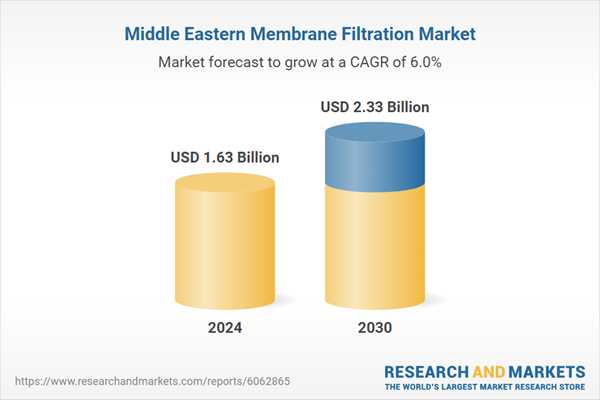Speak directly to the analyst to clarify any post sales queries you may have.
10% Free customizationThis report comes with 10% free customization, enabling you to add data that meets your specific business needs.
Key Market Drivers
Growing Food and Beverage Industry
The expanding food and beverage sector in the Middle East is another significant driver for the region’s membrane filtration market. With increasing consumer demand for processed, hygienic, and high-quality food and beverages, manufacturers are turning to advanced filtration technologies to meet safety and regulatory standards. Membrane filtration, especially microfiltration and ultrafiltration, is essential for applications such as milk and juice clarification, whey protein concentration, and beverage sterilization. Membrane filtration is widely used in the region’s growing dairy, juice, bottled water, and beverage segments, where hygiene, microbial safety, and product consistency are critical.As countries like Saudi Arabia, the UAE, and Qatar diversify their economies away from oil dependency, they are investing more in local food production and processing facilities. This diversification strategy is boosting the adoption of membrane systems that ensure product consistency, extend shelf life, and reduce microbial load without the use of heat or chemicals.
The rise in health-conscious consumers is driving demand for natural and additive-free products, encouraging food processors to adopt membrane filtration to achieve cleaner labels. International food and beverage companies establishing operations in the Middle East also bring with them stringent quality control processes, often centered around advanced filtration technologies. Consequently, the growing need for safety, efficiency, and sustainability in food and beverage processing is creating significant opportunities for membrane filtration suppliers in the region.
Key Market Challenges
High Capital and Operational Costs
One of the most significant challenges facing the membrane filtration market in the Middle East is the high capital and operational costs associated with these technologies. Despite their efficiency and long-term benefits, membrane filtration systems - especially those used in desalination and wastewater treatment - require a substantial initial investment. This includes the cost of acquiring advanced membranes, setting up infrastructure, and integrating control and monitoring systems. For many smaller municipalities, private firms, and developing regions within the Middle East, these upfront expenses can be a barrier to adoption.Beyond installation, operational costs are also considerable. Membrane systems typically require a constant energy supply, particularly in processes like reverse osmosis, which involve high-pressure pumps. Energy costs in the Middle East, although subsidized in some countries, still contribute to the overall expense of running large-scale membrane plants. Furthermore, maintaining membrane systems demands regular cleaning, membrane replacement, and skilled technical staff, all of which increase long-term costs.
Key Market Trends
Rising Adoption of Reverse Osmosis in Desalination Projects
A prominent trend in the Middle East membrane filtration market is the increasing reliance on reverse osmosis (RO) for desalination, especially in countries like Saudi Arabia, the UAE, and Oman. Traditionally, thermal desalination methods like multi-stage flash (MSF) dominated the region, but due to their high energy consumption and operational complexity, there has been a shift toward membrane-based RO systems. This transition is being driven by the improved efficiency, lower energy usage, and cost-effectiveness of modern RO membranes.Technological innovations have enhanced membrane durability, salt rejection capabilities, and resistance to fouling, making RO systems more viable in the region's challenging environments. In addition, the modular and scalable nature of RO plants makes them suitable for both large-scale urban centers and decentralized rural communities.
Governments are also playing a vital role in promoting this trend. National strategies such as Saudi Arabia’s Vision 2030 emphasize sustainable water management and encourage investments in energy-efficient technologies. Massive desalination projects like the Ras Al Khair and Taweelah plants are already setting new benchmarks in terms of capacity and operational efficiency.
This trend is expected to continue as climate change exacerbates water scarcity and population growth drives higher water demand. Reverse osmosis will likely remain at the forefront of the region’s desalination strategies, creating robust opportunities for membrane technology providers.
Key Market Players
- Toray Membrane
- Alfa Laval
- Koch Separation Solutions
- Suido Kiko Middle East
- Suez Water Technologies & Solutions
- 3M Gulf Limited
- AES Arabia Ltd.
- Advanced Watertek
- Pure Aqua
- Pall Water
Report Scope:
In this report, the Middle East Membrane Filtration Market has been segmented into the following categories, in addition to the industry trends which have also been detailed below:Middle East Membrane Filtration Market, By Product Type:
- Reverse Osmosis
- Ultrafiltration
- Microfiltration
- Nanofiltration
Middle East Membrane Filtration Market, By Application:
- Water & wastewater
- Food & Beverages
- Pharmaceuticals
- Others
Middle East Membrane Filtration Market, By Module Design:
- Spiral Wound
- Tubular Systems
- Plates & Frames
- Hollow Fibers
Middle East Membrane Filtration Market, By Membrane Material:
- Polymeric
- Ceramic
Middle East Membrane Filtration Market, By Country:
- Saudi Arabia
- UAE
- Qatar
- Kuwait
- Bahrain
- Oman
- Israel
- Rest of Middle East
Competitive Landscape
Company Profiles: Detailed analysis of the major companies present in the Middle East Membrane Filtration Market.Available Customizations:
With the given market data, the publisher offers customizations according to a company's specific needs. The following customization options are available for the report.Company Information
- Detailed analysis and profiling of additional market players (up to five).
This product will be delivered within 1-3 business days.
Table of Contents
Companies Mentioned
- Toray Membrane
- Alfa Laval
- Koch Separation Solutions
- Suido Kiko Middle East
- Suez Water Technologies & Solutions
- 3M Gulf Limited
- AES Arabia Ltd.
- Advanced Watertek
- Pure Aqua
- Pall Water
Table Information
| Report Attribute | Details |
|---|---|
| No. of Pages | 123 |
| Published | April 2025 |
| Forecast Period | 2024 - 2030 |
| Estimated Market Value ( USD | $ 1.63 Billion |
| Forecasted Market Value ( USD | $ 2.33 Billion |
| Compound Annual Growth Rate | 6.0% |
| Regions Covered | Middle East |
| No. of Companies Mentioned | 10 |









